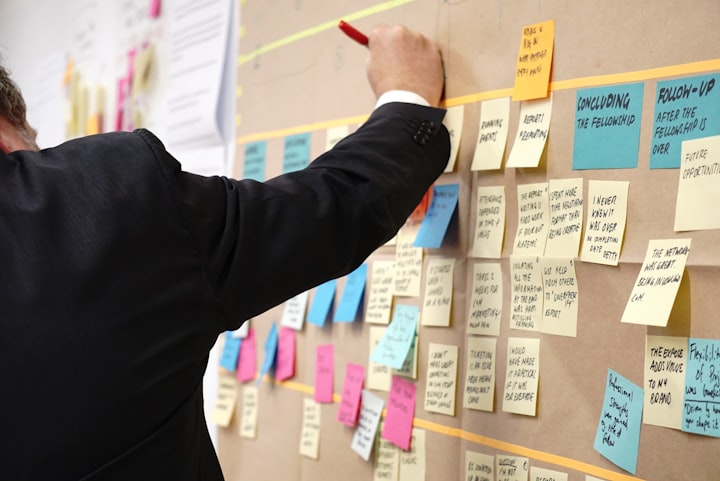Processes in Project Management: Phase 1 — Initiating Your Project
Taking these initial steps will ensure the success of your project

The key to success in any endeavor is careful initial planning. By taking the necessary preparatory steps before embarking on any journey, large or small, we can feel confident that we know our trajectory, have a good idea of what we’re aiming for, and can progress with a greater sense of clarity and purpose.
In the first stage of Project Management, the Initiation Phase, the Product Owner (the chief stakeholder, often an organization, that is initially proposing the project), the Project Sponsor, and the Project Manager lay the groundwork crucial to any successful project.
Processes in Phase 1: Project Initiation
1. Identify Problem Statement and Prepare Business Case
The Product Owner identifies the problem statement (e.g. “I require a special kind of software in order to streamline my business because my current resources are not providing the results I need”.) The Product Owner then builds a Business Case outlining why undertaking the project is necessary, and how they perceive the project will improve their business and/or achieve their goal. This also includes looking at the costs likely to be incurred and measuring these against the perceived cost benefits over the longer term. Essentially, the Business Case is the justification for seeking to undertake the project in the first place; the “why” of the project, if you will.
2. Conduct a Feasibility Study
Having established the goals of the project, timeline, and funding that will be required, the Product Owner assesses the overall strength of the business case and, more importantly, how practicable the intended project will be in practice. This includes assessing the technical side (are particular kinds of hardware, software or technical/IT support necessary to the implementation of the project? How might these impact upon the projected costs?), the legalities and/or ethics of the project, the feasibility in terms of the scheduling and the operational requirements, and the economic feasibility in terms of the financial outlay weighed against the intended benefit at the project’s completion.
If, in these early stages analysis shows that a proposed project is deemed unfeasible for any reason, the project will halt in its tracks and not go ahead.
3. Prepare Project Proposal and Request Budget
The feasibility of the project having been affirmed, the Product Owner can then prepare their project proposal for the Project Sponsor, essentially, explaining the Owner’s context for requesting the work, outlining their requirements, what they envisage as their intended outcomes as and what they believe will be the key benefits that will result from undertaking the project.
Once they have prepared their Project Proposal, the Product Owner will then submit it to the Project Sponsor and request the funding necessary for undertaking the project.
4. Approval of the Proposal and Allocation of Budget
It is then the task of the Project Sponsor to evaluate the proposal and decide whether to approve the request. If the proposal is accepted, then the Sponsor will allocate the necessary funding for the project.
5. Assign the Project Manager
The Project Sponsor then assigns a Project Manager, who see the project through to the end of the first initiation phase right through the planning, execution, implementation to the final, closing phase. As such, they need to be highly organized and meticulous planners if the project it to remain on track through to its closure and successful delivery. Once they have been assigned, it will be the Project Manager’s task to manage the team, monitor progress, and keep the project on time and on budget.
6. Identify Project Stakeholders, Their Influence and Their Risk Tolerance
Once established in the role, the Project Manager will identify the project’s stakeholders, those who have a vested interest in the successful implementation of the proposal, and establishing what influence their needs and goals are likely to have on the project. An important part of this is evaluating their risk appetite, risk-tolerance, and risk threshold; in other words, how much risk and uncertainty they are able to withstand on the way toward the end goal. A stakeholder with a higher risk appetite will be willing to accept if the timeline gets a little off-track along the way; they can weather the impact to the project’s final delivery date and are happy to do so in the knowledge that the outcome of the delay will be ultimately benefit their project. Conversely, the risk averse stakeholder would have a far lower threshold for any schedule slippage.
7. Define Project Objectives and High-Level Timeline
The level of stakeholder risk tolerance will influence the Project Manager in further defining and clearly establishing the project’s ultimate objectives and high-level timeline as well as enabling them to identify potential risk factors and include suggested mitigation strategies into a Project Charter.
8. Define the Scope of Work
The scope of work document that is developed by the Project Manager is, in effect, the response to the Product Owner’s original proposal document. It outlines what they as Project Manager are able to provide the Owner. This will include, but is not limited to, deliverables (the finished product itself), a projected timeline establishing the major phases of the project and when they will be completed, the key milestones by which progress on the project will be monitored, and reports, data and any other regular updates and progress reviews.
9. Develop the Project Charter
Having established the scope of the work, the Project Manager now creates the Project Charter. This document finalizes the plans for the project and formalizes the agreement. It is a formal recording that forms the backbone for the ongoing project; the reason for the project being undertaken, the potential risks and constraints, the identities of the stakeholders, the outline of the intended course ahead in order to fulfil the requirements of the project, and the high-level finance and budgeting information.
10. Product Owner Reviews Project Charter
Once the Project Charter has been developed, it is then presented to the Product Owner to review, negotiate any amendments and reach agreement with the Project Manager on what will be delivered at the project’s end-date.
11. Project Sponsor Reviews and Approves or Rejects Project Charter
The Project Charter then passes to the Project Sponsor for their review. They will evaluate the Charter and, if they are happy that the intended project provides a cost-effective and timely way forward, they will approve the final document. The Project Charter then becomes the formal authorization document for the project to go ahead into the second Project Management Phase, the Project Planning.
Next in this series: "Processes in Project Management: Phase 2 — Fine-Tuning for Successful Implementation"
©️ Jupiter Grant 2020
Enjoyed the article? I'd love it if you left a small tip, or buy me a coffee here: https://ko-fi.com/jupitergrant
About the Creator
Jupiter Grant
Writer, Poet, Narrator, Audiobook Producer, Freelancer.
As you may have guessed, Jupiter Grant is my nom de plume. I’m a purveyor of fiction, poetry, pop culture, and whatever else takes my fancy on any given day.






Comments
There are no comments for this story
Be the first to respond and start the conversation.